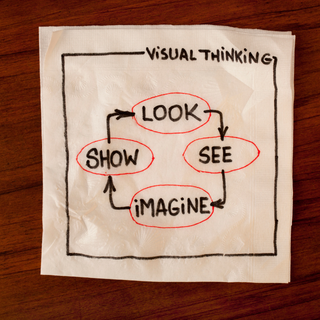
Visual Thinking Strategies is a video lesson designed for administrators and guides. The video lesson discusses how it can help the child develop visual thinking skills.
What is a Visual Thinking Strategy (VTS)?
Visual Thinking Strategy (VTS) was developed by cognitive psychologist Abigail Housen and museum educator Philip Yenawineare. It is based on Housen’s theory of Aesthetic Development and the corresponding research.
Visual Thinking Strategy (VTS) is an inquiry-based teaching method that strives to increase students’ proficiency in describing, analyzing, and interpreting images and information based on visual observation and discussion. It supports the development of critical thinking skills and encourages participation in collaborative discussions, especially among students who struggle with traditional text-based or lecture-based learning environments.
Visual Thinking Strategies address two growing challenges in schools:
- the need to improve argument writing among children
- to increase students’ limited exposure to art.
How to Boost Visual Thinking Skills in Children?
According to the VTS official website, developing critical and creative thinking skills can lead to increased visual literacy for students across all fields of study.
At the core, we ask children three key questions (there are 6 points below and not the questions) to thrive in their creative skills:
- What’s going on in this picture?
- What do you see that makes you say that?
- What more can we find?
How to Introduce a Visual Thinking Strategy to the Child?
To use visual thinking strategies in the classroom, follow the following steps:
- Show a picture to the child and start the discussion by asking, “What’s going on in this picture?”
- Allow the child to take 2-3 minutes to observe the art picture.
- After that, encourage children to back up their comments with evidence by asking, “What do you see that makes you say that?”
- Let the child come up with answers.
- Once the child answers, invite differing opinions by saying, “What more can we find?”
- Repeat the process to transform the way children think and learn.
Facilitating discussions of visual art helps increase children’s engagement, performance, and enjoyment in the learning process.
The pilot study was conducted in 20202 to evaluate a novel professional development (PD) model designed to prepare K–12 educators in high-need rural school districts to teach evidence-based argument writing. It showed how engaging children in discussions about visual art using VTS enhanced students’ argumentative writing.
Additionally, the session guides teachers and administrators on how to build visual thinking skills in children through art.
The video lesson further guides us on how such activities are insightful and valuable as they help the child exercise their brain and work on their visual skills.
Watch the video and learn some useful tips to conduct a successful visual thinking strategy session with children.
Related Video Resources
- Re-enrollment strategies
- Preparing physical environment at school post-pandemic
- Introducing the child to art studies
- Reopening schools post pandemic
For more videos for Montessori administrators and guides, click here.
Video Created by: Catherine Lewis
Tags





